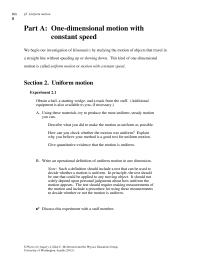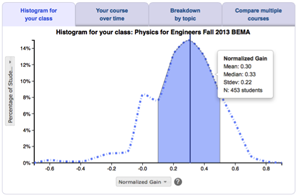
Developed by: Lillian C. McDermott, Peter S. Shaffer and the Physics Education Group at UW



middle schoolhigh schoolintro collegeinter-mediateupper levelgrad school other

conceptual









Overview
What? A lab-based guided-inquiry curriculum for future and current teachers to develop deep understanding of physics content and scientific reasoning skills. Students make observations, develop physical concepts, use and interpret scientific representations, and construct predictive explanatory models.
Why? PBI has been rigorously tested and validated. It is designed to help secondary teachers develop reasoning skills to anticipate student roadblocks, then channel existing conceptions into deeper understanding through a lab-based approach. Easy to implement on a limited equipment budget.
Why not? Requires skilled facilitators to spend a lot of time with each group of students. Because students discuss each topic in depth, you can't cover as many topics. The PBI textbook, available only through a publisher, is costly and may be unaffordable for many students.
Topic outline
VOLUME I:
PROPERTIES OF MATTER
Measurements of Matter
Pure Substances
Scientific Representations
Solutions of Solids in Water
Solutions of Solids, Liquids, and Gases
HEAT AND TEMPERATURE
Measurements of Heat and Temperature
Thermal Properties of Matter
LIGHT AND COLOR
Light and Shadows
Pigments and Colored Light
MAGNETS
Behavior of Magnets
Magnetic Materials
ASTRONOMY BY SIGHT: THE SUN, MOON, AND STARS
VOLUME II:
ELECTRIC CIRCUITS
Behavior of Simple Electric Circuits
Measurements of Current and Resistance
Measurement of Voltage
Batteries and Bulbs in Everyday Life
ELECTROMAGNETS
LIGHT AND OPTICS
Plane Mirrors and Images
Lenses, Curved Mirrors, and Images
KINEMATICS
Motion with Constant Speed
Motion with Changing Speed
Graphical Representations of Motion
Algebraic Representations of Motion
ASTRONOMY BY SIGHT: THE EARTH AND THE SOLAR SYSTEM
Student skills developed
- Conceptual understanding
- Making real-world connections
- Using multiple representations
- Designing experiments
- Metacognition
Instructor effort required
- High
Resources required
- Simple lab equipment
- Cost for students
- Tables for group work
Resources
Teaching Materials
Physics by Inquiry comes in two volumes of books published by Pearson. You can order them from Pearson (Vol. I and Vol. II) or from Amazon (Vol. I and Vol. II). You can download a sample excerpt from PhysPort.
The developers recommend visiting the Physics Education Group at the University of Washington to learn how to implement this curriculum.
Research
This is the second highest level of research validation, corresponding to:
- at least 1 of the "based on" categories
- at least 2 of the "demonstrated to improve" categories
- at least 4 of the "studied using" categories
Research Validation Summary
Based on Research Into:
- theories of how students learn
- student ideas about specific topics
Demonstrated to Improve:
- conceptual understanding
- problem-solving skills
- lab skills
- beliefs and attitudes
- attendance
- retention of students
- success of underrepresented groups
- performance in subsequent classes
Studied using:
- cycle of research and redevelopment
- student interviews
- classroom observations
- analysis of written work
- research at multiple institutions
- research by multiple groups
- peer-reviewed publication
References
- G. Aubrecht II, Student Perceptions of Three Different Physics by Inquiry Classes using the Laboratory Program Variables Inventory, presented at the Physics Education Research Conference 2007, Greensboro, NC, 2007.
- G. Aubrecht II, Y. Lin, D. Demaree, D. Brookes, and X. Zou, Student Perceptions of Physics by Inquiry at Ohio State, presented at the Physics Education Research Conference 2005, Salt Lake City, Utah, 2005.
- C. Bowman and G. Aubrecht II, Voltage is the Most Difficult Subject for Students in Physics by Inquiry's Electric Circuits Module, presented at the Physics Education Research Conference 2007, Greensboro, NC, 2007.
- D. Kaltakci-Gurel, A. Eryilmaz, and L. McDermott, Development and application of a four-tier test to assess pre-service physics teachers’ misconceptions about geometrical optics, Res. Sci. & Technol. Educ. 35 (2), 238 (2017).
- Y. Kim, L. Bao, and O. Acar, Students' Cognitive Conflict and Conceptual Change in a Physics by Inquiry Class, presented at the Physics Education Research Conference 2005, Salt Lake City, Utah, 2005.
- B. Lindsey, L. Hsu, H. Sadaghiani, J. Taylor, and K. Cummings, Positive attitudinal shifts with the Physics by Inquiry curriculum across multiple implementations, Phys. Rev. ST Phys. Educ. Res. 8 (1), 010102 (2012).
- L. McDermott, Combined physics course for future elementary and secondary school teachers, Am. J. Phys. 42 (8), 668 (1974).
- L. McDermott, Practice teaching program in physics for future elementary school teachers, Am. J. Phys. 42 (9), 737 (1974).
- L. McDermott, Teacher education and the implementation of elementary science curricula, Am. J. Phys. 44 (5), 434 (1976).
- L. McDermott, A perspective on teacher preparation in physics and other sciences: The need for special science courses for teachers, Am. J. Phys. 58 (8), 734 (1990).
- L. McDermott and P. Shaffer, Preparing Teachers to Teach Physics and Physical Science by Inquiry, in The Role of Physics Departments in Preparing K-12 Teachers, edited by G. Buck, J. Hehn, and D. Leslie-Pelecky, (2000), p. 71.
- L. McDermott, P. Shaffer, and C. Constantinou, Preparing teachers to teach physics and physical science by inquiry, Phys. Educ. 35 (6), 411 (2000).
- H. Sadaghiani, Physics By Inquiry: Addressing Student Learning and Attitude, presented at the Physics Education Research Conference 2008, Edmonton, Canada, 2008.
- K. Trundle, R. Atwood, and J. Christopher, Preservice elementary teachers' conceptions of moon phases before and after instruction, J. Res. Sci. Teaching 39 (7), 633 (2002).





